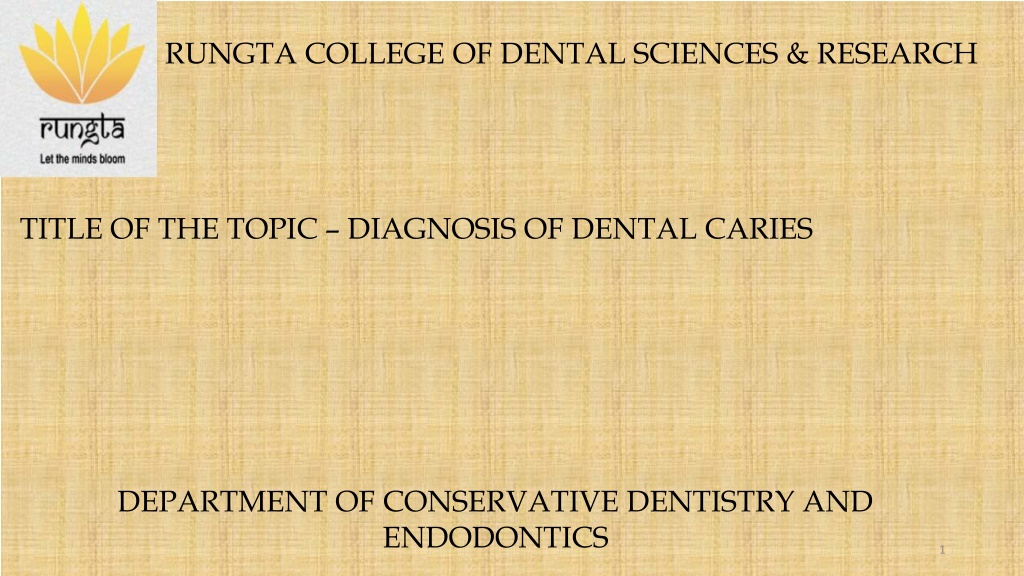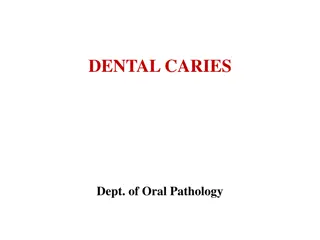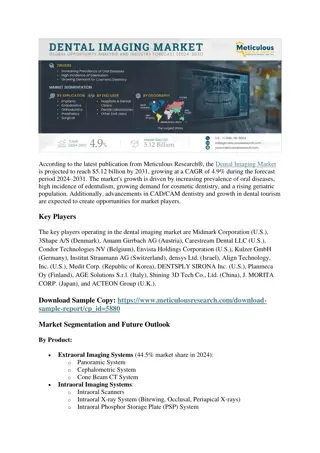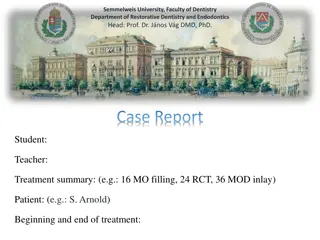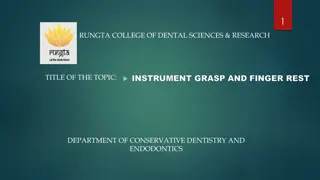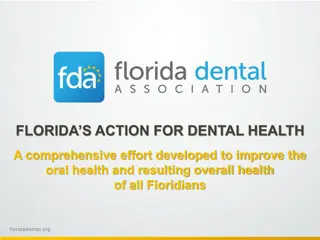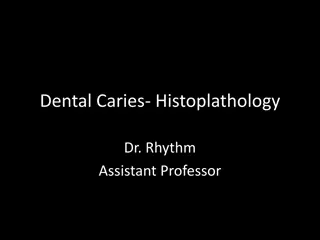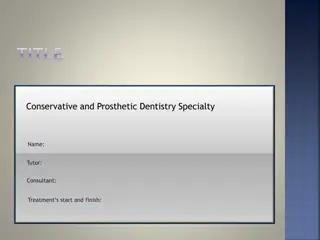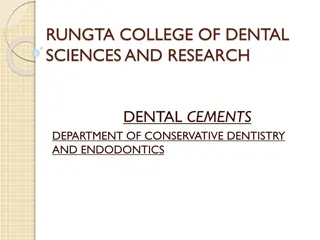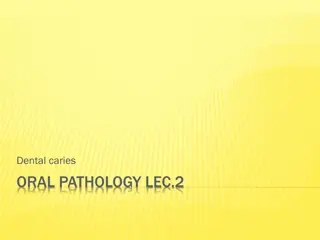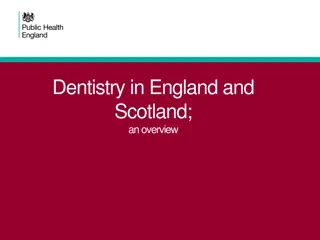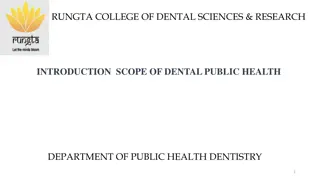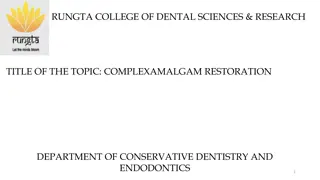Understanding the Diagnosis of Dental Caries in Conservative Dentistry and Endodontics
This presentation covers the classification of dental caries based on anatomical site, focusing on pit and fissure caries. It discusses the development, appearance, and diagnosis of pit and fissure caries, as well as the morphology of fissures. Learners will gain knowledge on the specific learning objectives related to the diagnosis of dental caries. Visual aids and detailed information enhance the understanding of this important topic in dentistry.
Download Presentation

Please find below an Image/Link to download the presentation.
The content on the website is provided AS IS for your information and personal use only. It may not be sold, licensed, or shared on other websites without obtaining consent from the author. Download presentation by click this link. If you encounter any issues during the download, it is possible that the publisher has removed the file from their server.
E N D
Presentation Transcript
RUNGTA COLLEGE OF DENTAL SCIENCES & RESEARCH TITLE OF THE TOPIC DIAGNOSIS OF DENTAL CARIES DEPARTMENT OF CONSERVATIVE DENTISTRY AND ENDODONTICS 1
Specific learning Objectives At the end of this presentation the learner is expected to know ; Core areas* Domain ** Category # classification Cognitive Must know *Subtopic of importance ** Cognitive, Psychomotor or Affective # Must know , Nice to know & Desire to know ( Table to be prepared as per the above format ) 2
CONTENT Classification of dental caries Questions Take home message references
CLASSIFICATION OF DENTAL CARIES
1.BASED ON ANATOMICAL SITE OCCLUSAL (PIT AND FISSURE) SMOOTH SURFACE CARIES (PROXIMAL AND CERVICAL CARIES) LINEAR ENAMEL CARIES ROOT CARIES
PIT AND FISSURE CARIES PIT AND FISSURE CARIES of the primary type develops in the occlusal surface of molar and premolar,in the buccal and lingual surface of the molar and in the palatal surface of the maxillary incisors. Shape, morphological variation and depth of pit and fissures contributes to their high susceptibility to caries. Enamel in the extreme depth is very thin or occasionally absent and thus allows the exposure of dentin.
Pit and fissures affected by early caries may appear brown or black and will feel slightly soft and catch a fine explorer point. Entry site may appear much smaller than actual lesion, making clinical diagnosis difficult. Carious lesion of pits and fissures develop from attack on their walls. In cross section, the gross appearance of pit and fissure lesion is inverted V with a narrow entrance and a progressively wider area of involvement closer to the DEJ.
MORPHOLOGY OF FISSURES NANGO (1960):Based on the alphabetical description of shape 4 types V&U type: self cleansing and somewhat caries resistant U type: narrow slit like opening with a larger base as it extend towards DEJ K type: also very susceptible to caries
Smooth surface caries Less favorable site for plaque attachment, usually attaches on the smooth surface that are near the gingiva or are under proximal contact.. In very young patients the gingival papilla completely fills the interproximal space under a proximal contact and is termed as col. Also crevicular spaces in them are less favorable habitats for s.mutans. Consequently proximal caries is less lightly to develop where this favorable soft tissue architecture exists.
The proximal surfaces are particularly susceptible to caries due to extra shelter provided to resident plaque owing to the proximal contact area immediately occlusal to plaque. Lesion have a broad area of origin and a conical, or pointed extension towards DEJ. V shape with apex directed towards DEJ. After caries penetrate the DEJ softening of dentin spread rapidly and pulpally
Linear enamel caries Linear enamel caries ( odontoclasia ) is seen to occur in the region of the neonatal line of the maxillary anterior teeth. The line, which represent a metabolic defect such as hypocalcemia or trauma of birth, may predispose to caries, leading to gross destruction of the labial surface of the teeth. Morphological aspects of this type of caries are atypical and results in gross destruction of the labial surfaces incisor teeth
ROOT SURFACE CARIES The proximal root surface, particularly near the cervical line, often is unaffected by the action of hygiene procedures, such as flossing, because it may have concave anatomic surface contours (fluting) and occasional roughness at the termination of the enamel. These conditions, when coupled with exposure to the oral environment (as a result of gingival recession), favor of mature, caries-producing plaque and proximal root-surface caries. the formation Root-surface caries is more common in older patients. Caries originating on the root is alarming because 1. it has a comparatively 2. it is often asymptomatic 3. it is closer to the pulp 4, it is more difficult to restore rapidprogression
The root surface is refer the enamel and readily allows plaque formation in the absence of good oral hygiene. The cementum covering the root surface is extremely thin and provides littleresistance to caries attack. Root caries lesions have less well-defined margins, tend to be U-shaped in cross sections, and progress more rapidly because of the lack of protection from and enamel covering.
2.BASED ON PROGRESSION ACUTE CARIES ARRESTED CARIES CHRONIC CARIES
ACUTE CARIES Acute caries is a rapid process involving a large number of teeth. These lesions are lighter colored than the other types, being light brown or grey, and their caseous consistency makes the excavation difficult. Pulp exposures and sensitive teeth are often observed in patients with acute caries. It has been suggested that saliva does not easily penetrate the small opening to the carious lesion, so there are little opportunity for buffering or neutralizaton
CHRONIC CARIES These lesions are usually of long-standing involvement, affect a fewer number of teeth, and are smaller than acute caries. Pain is not a common feature because of protection afforded to the pulp by secondary dentin The decalcified dentin is dark brown and leathery. Pulp prognosis is hopeful in that the deepest of lesions usually requires only prophylactic capping and protective bases. The lesions range in depth and include those that have just penetrated the enamel.
ARRESTED CARIES Caries which becomes stationary or static and does not show any tendency for further progression Both deciduous and permanent affected With the shift in the oral conditions, even advanced lesions may become arrested . Arrested caries involving dentin shows a marked brown pigmentation and induration of the lesion [the so called eburnation of dentin ] Sclerosis of dentinal tubules and secondary dentin formation commonly occur
Exclusively seen in caries of occlusal surface with large open cavity in which there is lack of food retention Also on the proximal surfaces of tooth in cases in which the adjacent approximating tooth has been extracted
3.BASED ON VIRGINITY Of LESION INITIAL/PRIMARY RECURRENT/SECONDARY
PRIMARY CARIES(INITIAL) A primary caries is one in which the lesion constitutes the initial attack on the tooth surface. The designation of primary is based on the initial location of the lesion on the surface rather than the extent of damage.
SECONDARY CARIES (RECURRENT) This type of caries is observed around the edges and under restorations. The common locations of secondary caries are the rough or overhanging margin and fracture place in all locations of the mouth. It may be result of poor adaptation of a restoration, which allows for a marginal leakage, or it may be due to inadequate extension of the restoration. In addition caries may remain if there has not been complete excavation of the original lesion, which later may appear as a residual or recurrent caries.
4. BASED ON EXTENT OF CARIES INCIPIENT CARIES CAVITATION OCCULT CARIES
INCIPIENTCARIES The early caries lesion, best seen on the smooth surface of teeth, is visible as a white spot . Histologically the lesion has an apparently intact surface layer overlying subsurface demineralization. Significantly may such lesion can undergo remineralization and thus the lesion is not an indication for restorative treatment
These white spot lesion may be confused initially with white developmental defects of enamel formation, which can be differentiated by their position away from the gingival margin], their shape [unrelated to plaque accumulation] and their symmetry [they usually affect the contralateral tooth]. Also on wetting the caries lesion disappear while the developmental defect persist
It is believed that bite wing and OPG radiographs along with noninvasive adjuncts like fiber optic transillumination (FOTI),laser luminescence, electrical resistance method (ERM) are used for diagnosis these occlusal lesions. These lesion are not associated with microorganisms different to those found in other carious lesion. These carious lesion seem to increase with increasing age. Occult carious lesion are usually seen with low caries rate which is suggestive of increase fluid exposure.
It is believed that increased fluid exposure encourages remineralization and slow down progress of the caries in the pit and fissure enamel while the cavitations continues in dentine, and the lesions become masked by a relatively intact enamel surface. These hidden lesions are called as fluoride bombs or fluoride syndrome. Recently it is seen that occult caries may have its origin as pre- eruptive defects which are detectable only with the use of radiographs.
Once it reaches the dentinoenamel junction, the caries process has the potential to spread to the pulp along the dentinal tubules and also spread in lateral direction. Thus some amount of sensitivity may be associated with this type of lesion. This may be generally accompanied by cavitation
5.Based involvement on tissue 1. Initial caries 2. Superficial caries 3. Moderate caries 4. Deep caries 5. Deep complicated caries
Dental caries can be divided into 4 or 5 Initial caries: Demineralization without structural defect. This stage can be reversed by fluoridation and enhanced mouth hygiene Superficial caries (Caries superficialis):Enamel caries, wedge- shaped structural defect. Caries has affected the enamel layer, but has not yet penetrated the dentin.
3. Moderate caries (Caries media): Dentin caries. Extensive structural defect. Caries has penetrated up to the dentin and spreads two- dimensionally beneath the enamel defect where the dentin offers little resistance. 4. Deep caries (Caries profunda): Deep structural defect. Caries has penetrated up to the dentin layers of the tooth close to the pulp. 5. Deep complicated caries (Caries profunda complicata) :Caries has led to the opening of the pulp cavity (pulpa aperta or open pulp).
TAKE HOME MESSAGE Dental caries is the most common chronic disease in the world It is a multifactorial disease Tetrad of dental caries include- host, substrate ,flora,time
Questions Define dental caries GV Black classification theories of dental caries
REFRENCES John I. ingle,DDS,MSD Endodontics Fifth edition M.A.Marzouk,A.L.Simonton,R.D.Gross Modern Theory and Practice Operative Dentistry. Shaffers Textbook Of Oral Pathology and Medicine
THANK YOU 37
